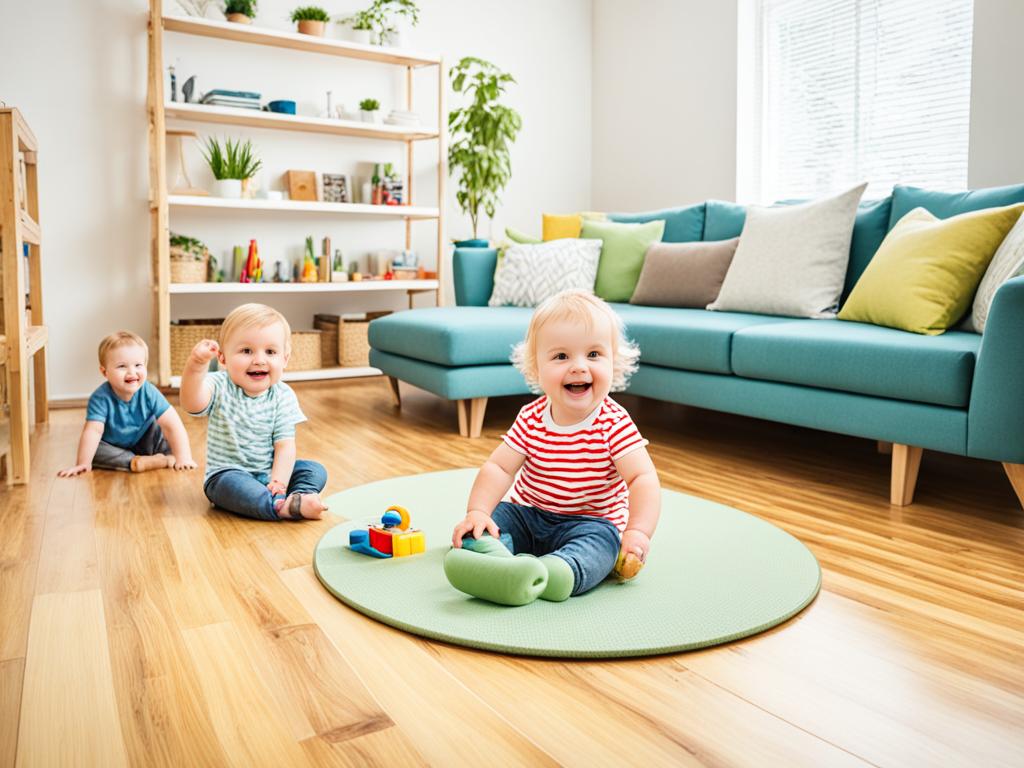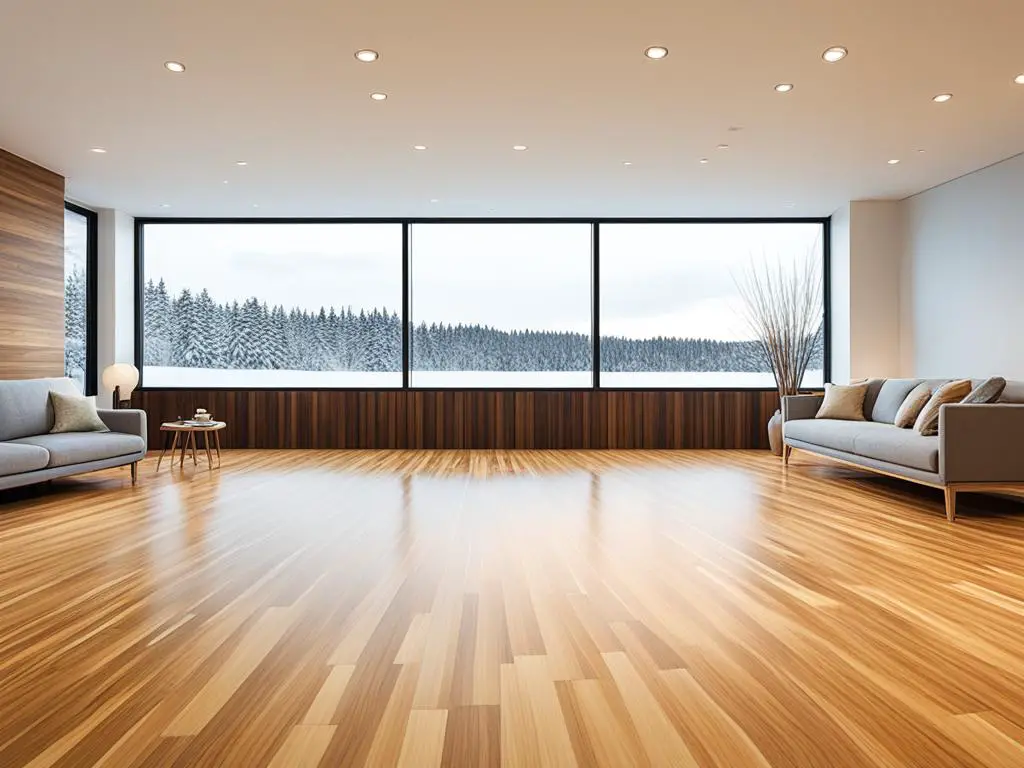When it comes to choosing the best flooring options for your home or office, bamboo flooring is a popular choice. Not only is it durable and eco-friendly, but it also adds a touch of natural elegance to any space. However, before you can enjoy the beauty of bamboo flooring, you need to decide on the installation method. Two common options are floating floor and glue down bamboo. Let’s explore the differences in installation methods and weigh their pros and cons.
Key Takeaways:
- Floating floor installation is easy and versatile, suitable for DIY enthusiasts. It can be installed over various subfloors, including concrete, wood, vinyl, or existing floors.
- Glue down bamboo flooring offers stability and durability, making it ideal for high-traffic areas. Professional installation is required, and it is more time-consuming and costly compared to floating floor installation.
- Consider the type of subfloor, your desired installation method, and the specific pros and cons of each before making a decision.
- Bamboo flooring comes in different options, including stranded bamboo, horizontal bamboo, and engineered bamboo. Each has its own manufacturing process and installation requirements.
- Bamboo flooring is a renewable material and easy to maintain. However, it is important to choose formaldehyde-free options and protect it from direct sunlight and humidity swings.
Pros and Cons of Floating Floor vs Glue Down Bamboo
When it comes to choosing between floating floor and glue down bamboo flooring, it’s essential to understand the benefits and advantages each option offers. Let’s explore the pros and cons of both installation methods to help you make an informed decision.
Floating Floor Installation:
Benefits:
- Easy installation: Floating floors feature interlocking planks that simply click together, making it a straightforward process.
- Suitable for DIY installation: Since no adhesives or nails are required, floating floors can be a great choice for homeowners looking to install the flooring themselves.
- Versatility: Floating floors can be installed over various subfloors, including concrete, wood, or existing vinyl or wood floors, offering flexibility in application.
Glue Down Bamboo Flooring:
Advantages:
- Stability and durability: Glue down bamboo flooring provides exceptional stability and durability, as the planks are directly bonded to the subfloor.
- Recommended for high foot traffic areas: Due to its secure installation method, glue down flooring is ideal for areas that experience heavy foot traffic, enhancing its longevity.
While both floating floor and glue down bamboo flooring have their advantages, there are a few factors to consider when making a decision. Here’s a quick comparison:
| Floating Floor | Glue Down Bamboo Flooring |
|---|---|
| Easy installation | Stability and durability |
| Suitable for DIY | Recommended for high foot traffic areas |
| Versatile application | Professional installation required |
| Higher cost and time-consuming installation |
Note: It’s crucial to weigh the benefits and advantages to determine the best flooring option for your specific needs. Factors such as the type of subfloor, installation preferences, and budget should also be considered.

Bamboo Flooring Options and Manufacturing Process
Bamboo flooring offers a range of options, each with its own unique manufacturing process. Understanding these options can help you make an informed decision when choosing the right bamboo flooring for your space.
1. Stranded Bamboo Flooring
Stranded bamboo flooring is made by shredding bamboo stalks into small strands. These strands are then compressed into sheets using heat and resin binders before being cut into planks. Stranded bamboo flooring provides exceptional durability and strength, making it perfect for high-traffic areas. It comes in tongue-and-groove planks, suitable for both nailing down and floating floor installations.
2. Horizontal Bamboo Flooring
Horizontal bamboo flooring is created by cutting bamboo strands into thin strips, which are then glued together to form planks. This type of bamboo flooring showcases a unique grain pattern, giving your space a distinct and natural look. Like stranded bamboo flooring, horizontal bamboo flooring is available in both nail-down and floating installations.
3. Engineered Bamboo Flooring
Engineered bamboo flooring features a thin layer of bamboo that is bonded to a plywood or MDF core. This construction offers excellent stability and resistance to moisture. Engineered bamboo flooring is installed using click-lock planks that float over a foam underlayment, making it a popular choice for DIY enthusiasts. It is the most cost-effective bamboo flooring option but cannot be refinished.
By understanding the different types of bamboo flooring options and their manufacturing processes, you can select the one that best suits your style, budget, and installation preferences.

| Bamboo Flooring Option | Manufacturing Process |
|---|---|
| Stranded Bamboo Flooring | Shredding bamboo stalks into small strands Compressing strands into sheets with heat and resin binders Cutting sheets into planks |
| Horizontal Bamboo Flooring | Cutting bamboo strands into thin strips Gluing strips together to form planks |
| Engineered Bamboo Flooring | Bonding a thin bamboo layer to a plywood or MDF core Using click-lock planks that float over a foam underlayment |
Environmental Considerations and Maintenance of Bamboo Flooring
Bamboo flooring is a popular choice for homeowners due to its numerous benefits, including its status as a renewable material and easy maintenance requirements. By understanding the environmental considerations and best practices for maintenance, you can ensure the longevity and sustainability of your bamboo flooring.
Renewable Material
Bamboo is considered a renewable material due to its rapid growth and ability to be harvested without harming the plant. Unlike hardwood trees that take decades to mature, bamboo stalks can reach maturity within 3-5 years, making it an eco-friendly flooring option. By choosing bamboo flooring, you are supporting sustainable practices and reducing your ecological footprint.
Easy Maintenance
Maintaining bamboo flooring is relatively simple and requires minimal effort. Regular sweeping or vacuuming is essential to remove debris and prevent scratching from grit and dirt particles. Additionally, occasional damp mopping with a non-wax, non-alkaline cleaner will help keep the floor clean and fresh. Avoid using harsh cleaning chemicals or excessive water, as they can cause damage to the finish or bamboo fibers.
Toxins Present in Adhesives
While bamboo flooring itself is a natural and non-toxic material, it is important to be aware of the adhesives used during the manufacturing process. Some adhesives may contain toxins, such as formaldehyde, which can pose health risks. The level of formaldehyde can vary depending on the manufacturer and product. To minimize exposure to toxins, it is recommended to choose formaldehyde-free bamboo flooring options. Ensure that the flooring you select meets the necessary environmental standards and certifications to ensure a healthier indoor environment.
Maintenance Tips:
- Sweep or vacuum regularly to remove debris and prevent scratching.
- Occasionally damp mop using a non-wax, non-alkaline cleaner.
- Avoid using harsh cleaning chemicals or excessive water.
- Protect the floor from direct sunlight to prevent fading or discoloration.
- Maintain indoor humidity levels within the recommended range to prevent warping or shrinking.

By following these maintenance tips and considering the environmental impact of your bamboo flooring choices, you can enjoy a beautiful and sustainable flooring option in your home.
Conclusion
When considering the installation of a new bamboo floor, two popular options to choose from are floating floor installation and glue down bamboo flooring. Each method has its own unique advantages and disadvantages to consider.
Floating floor installation offers a convenient and versatile option. It is a DIY-friendly method that involves interlocking the planks and allowing them to “float” over the subfloor. This installation method can be used on various subfloor types and is suitable for those who prefer an easy and hassle-free installation process.
On the other hand, glue down bamboo flooring provides superior stability and durability. This method involves bonding the bamboo planks directly to the subfloor using flexible flooring adhesive. Glue down installation is recommended for areas with high foot traffic and requires professional installation for optimal results.
When choosing between these two options, it is crucial to consider your specific needs and preferences. Evaluate factors such as the subfloor type, desired level of stability, and installation expertise. Additionally, keep in mind the various bamboo flooring options available, including stranded bamboo, horizontal bamboo, and engineered bamboo.
Ultimately, both floating floor and glue down bamboo flooring can be excellent choices for your new floor. Make sure to thoroughly assess the pros and cons of each method, consider your specific requirements, and select the option that best suits your home and lifestyle.
FAQ
What are the installation methods for bamboo flooring?
Bamboo flooring can be glued down or installed as a floating floor, depending on the type of subfloor.
What types of subfloors are suitable for glue down installation?
Glue down installation requires a solid and sound subfloor, such as concrete, screed, or wooden floor boards.
Can bamboo flooring be nailed down?
Yes, bamboo flooring can be nailed down, but it is typically only suitable for wooden subfloors or when installing over joists.
What are the benefits of floating floor installation?
Floating floor installation is easy and suitable for DIY, as the planks simply click together and float over the subfloor.
Can floating floor be installed over different types of subfloors?
Yes, floating floors can be installed over concrete, wood subfloors, or existing vinyl or wood floors.
What are the advantages of glue down bamboo flooring?
Glue down installation offers added stability and durability, making it suitable for areas with high foot traffic.
Is professional installation required for glue down bamboo flooring?
Yes, glue down installation requires professional expertise and can be more costly and time-consuming.
What are the manufacturing processes for different types of bamboo flooring?
Stranded bamboo is made by shredding and compressing bamboo strands, horizontal bamboo is made by gluing thin bamboo strips, and engineered bamboo consists of a thin layer of bamboo bonded to a plywood or MDF core.
Is bamboo flooring a renewable material?
Yes, bamboo flooring is considered a renewable material as bamboo stalks grow quickly and can be harvested without harming the plant.
How do I maintain bamboo flooring?
Regular sweeping or vacuuming is recommended to remove debris, and occasional damp mopping with a non-wax, non-alkaline cleaner is necessary.
Are there any environmental considerations with bamboo flooring?
Some adhesives used in bamboo flooring manufacturing may contain formaldehyde, so it is important to choose formaldehyde-free options. Bamboo flooring can also be affected by direct sunlight and humidity swings.
Which installation method should I choose for bamboo flooring?
It depends on factors such as the subfloor type, your specific needs, and preferences. Consider the pros and cons of floating floor and glue down installation methods when making a decision.



